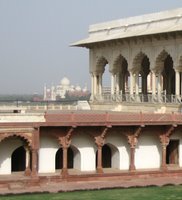The Taj
 Much has been written and much has been said about the beauty of the Taj Mahal. It's all true! The Taj Mahal constructed from 1632 to 1654 as a mausoleum for the wife of Shah Jahan, Mumtaz Mahal, is breathtaking.
Much has been written and much has been said about the beauty of the Taj Mahal. It's all true! The Taj Mahal constructed from 1632 to 1654 as a mausoleum for the wife of Shah Jahan, Mumtaz Mahal, is breathtaking.
 of gates, buildings and formal gardens. The front gate is nearly 1,000 feet from the Taj Mahal. In keeping with the Persian style of the ruling Moghul emperors, everything is symmetrical. The two grand red sandstone outlying buildings to the left and right of the mausoleum are mirror images. The western building
of gates, buildings and formal gardens. The front gate is nearly 1,000 feet from the Taj Mahal. In keeping with the Persian style of the ruling Moghul emperors, everything is symmetrical. The two grand red sandstone outlying buildings to the left and right of the mausoleum are mirror images. The western building (below) is a mosque. Our guide referred to the building to the east as the “guesthouse.” We were surprised by the relatively small enclosed area offered by the guesthouse. More studied views of the Taj Mahal say the eastern building was constructed for architectural balance.
(below) is a mosque. Our guide referred to the building to the east as the “guesthouse.” We were surprised by the relatively small enclosed area offered by the guesthouse. More studied views of the Taj Mahal say the eastern building was constructed for architectural balance.
 There is much lore about the Taj Mahal. Our guide shared the often-repeated myth that Shah Jahan was planning to build a mausoleum for himself in black marble across the river from his wife’s resting place. Scholars believe that the foundations of the second Taj are actually the enclosing wall of a garden founded by Babur. It is said that Shah Jahan, following the death of his wife Mumtaz, shut himself up in his room. When he emerged the next morning, his hair had turned white. Ah…romance. Mumtaz died in Burhanpur giving birth to Shah Jahan’s 14th child while accompanying him, as a trusted advisor, on one of his military campaigns.
There is much lore about the Taj Mahal. Our guide shared the often-repeated myth that Shah Jahan was planning to build a mausoleum for himself in black marble across the river from his wife’s resting place. Scholars believe that the foundations of the second Taj are actually the enclosing wall of a garden founded by Babur. It is said that Shah Jahan, following the death of his wife Mumtaz, shut himself up in his room. When he emerged the next morning, his hair had turned white. Ah…romance. Mumtaz died in Burhanpur giving birth to Shah Jahan’s 14th child while accompanying him, as a trusted advisor, on one of his military campaigns.
 We arrived at the Taj Mahal very early to avoid the heat, crowds and the many beggars that line the approachway to the Taj. We were greeted by the morning sunlight reflecting off the eastern side of the Islamic-inspired onion-shaped dome. Capping this dome is a gilded spire or finial
We arrived at the Taj Mahal very early to avoid the heat, crowds and the many beggars that line the approachway to the Taj. We were greeted by the morning sunlight reflecting off the eastern side of the Islamic-inspired onion-shaped dome. Capping this dome is a gilded spire or finial that integrates traditional Islamic and Hindu styles. Shah Jahan was near the end of a long line of Moghul emperors who had ruled
that integrates traditional Islamic and Hindu styles. Shah Jahan was near the end of a long line of Moghul emperors who had ruled Many traditions are subject to the realities of the times. In a departure from the symmetrical custom of the time, Shah  Jahan joined his wife in the Taj Mahal. His stone casket is offset from the center point of the mausoleum that is occupied by his wife. It's the only asymmetrical feature of the whole site.
Jahan joined his wife in the Taj Mahal. His stone casket is offset from the center point of the mausoleum that is occupied by his wife. It's the only asymmetrical feature of the whole site.
The Moghuls had no clear set of rules regarding succession to the throne. God would choose the most worthy successor. The selection process won by one of Shah Jahan's sons, Aurangzeb, included the murder of his older brothers and imprisonment of his father in 1658.
murder of his older brothers and imprisonment of his father in 1658.
Maybe more lore…our guide shared that Shah Jahan sat imprisoned for eight years in his palace across the river from the Taj Mahal where he gazed upon his beloved wife’s tomb every day until his own death. Ah romance…

1 Comments:
Thank you so much for sharing your experiences in India with the rest of us! What an amazing time you must be having!
Post a Comment
<< Home